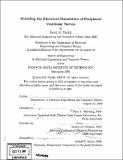Modeling the electrical stimulation of peripheral vestibular nerves
Author(s)
Parikh, Ketul M
DownloadFull printable version (11.23Mb)
Other Contributors
Massachusetts Institute of Technology. Dept. of Electrical Engineering and Computer Science.
Advisor
Marc S. Weinberg and Dennis M. Freeman.
Terms of use
Metadata
Show full item recordAbstract
The research conducted for this thesis investigated the theoretical placement of electrodes for a proposed implantable vestibular prosthesis to aid patients suffering from balance related disorders. The most likely sites of stimulation for the first-generation of such a device are the peripheral nerves responsible for transmitting rotational information to the brain. Although stimulation of such nerves has been performed in human and animal patients, little is known about the mechanisms responsible for the eliciting nerve responses. Models of the inferior and superior divisions of peripheral vestibular nerve were created to characterize the stimulus threshold behavior across the parameters of fiber diameter and location within the nerve. Current-distance relations were derived for nerve fibers excited by six commonly used electrode configurations. The threshold relations were used as a guide to determine the electrode configuration and location best-suited to stimulate the inferior vestibular nerve and selectively stimulate the branches of the superior vestibular nerve. The criteria used determine optimal placement included minimum current thresholds, configuration simplicity, and distance to the electrode. For the inferior nerve case, a cathodal stimulus located at a distance of 100 pm or 200 ym from the nerve and driven with a stimulus current of 56 pA or 76 pIA was recommended. For the superior vestibular nerve case we were interested in selectively stimulating each branch, imposing a further criteria to maximize the threshold ratio between stimulation of the respective branches. A transverse dipole electrode configurations was suggested that allowed selective stimulation of either branch. The configuration included a cathode located 300m from Branch 1 and an anode centrally located between both branches. (cont.) When driven with a cathodal stimulus of strength 51 pA, only Branch I was excited, while driving both electrodes with a magnitude of 106 jIA excited only Branch II. The proximity to the facial nerve was considered in the choices
Description
Thesis (M. Eng.)--Massachusetts Institute of Technology, Dept. of Electrical Engineering and Computer Science, 2006. Includes bibliographical references (p. 137-143).
Date issued
2006Department
Massachusetts Institute of Technology. Department of Electrical Engineering and Computer SciencePublisher
Massachusetts Institute of Technology
Keywords
Electrical Engineering and Computer Science.